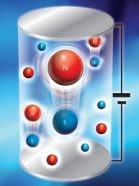Like electricity, but magnetic
Getting magnetic poles on the move makes a new kind of flow
Share this:
- Share via email (Opens in new window) Email
- Click to share on Facebook (Opens in new window) Facebook
- Click to share on X (Opens in new window) X
- Click to share on Pinterest (Opens in new window) Pinterest
- Click to share on Reddit (Opens in new window) Reddit
- Share to Google Classroom (Opens in new window) Google Classroom
- Click to print (Opens in new window) Print

Every magnet has two poles, the north and the south. It’s true for magnets big and small, short and tall. If you break a magnet into smaller pieces, then each small magnet ends up with a north and a south. (Magnets are said to be polarized, because they have two poles.) For magnets, if you have a north, you have a south.
That’s the case … usually.
But a recent experiment shows that even magnets can be broken up. In a new study, scientists, in a way, separate north poles from south poles. One pole without the other is called a monopole (mono- means one); the researchers also refer to these isolated poles as magnetic charges. After creating these monopoles, the scientists were able to make them move through a material. This movement of magnetic charges acts a lot like a current of electricity, the researchers report.
And that similarity gave the researchers a great reason to coin a new word. They call the flow magnetricity (combining the words magnet and electricity).
“We get them all going the same direction,” Sean Giblin told Science News. Giblin, a physicist at the Rutherford Appleton Laboratory in Oxfordshire (which is in the United Kingdom), worked on the new experiment.
It’s too early to start thinking about static magnetricity or plugging appliances into magnetric sockets ― though the researchers say they’d like to see magnetronic devices one day. The discovery does highlight some of the similarities between magnetism and electricity, so perhaps magnetricity’s day isn’t too far away.
Electricity flows from generators and batteries through power lines and wires. That electric flow is not liquid — it’s a fast parade of tiny charged particles called electrons. Each electron is a negative charge, and electric current is the movement of many negative charges in the same direction.
In the recent experiment, the current did not come from moving electrons ― it was magnetic, rather than electric. The scientists created the current in small crystals of a material called spin ice. Spin ice is made of unusual molecules shaped like pyramids with triangular bases. Imagine lots of these tiny pyramids linked together and you can imagine what spin ice looks like up close.
Each pyramid has four vertices (vertices is plural for vertex, a point where three sides come together). Each vertex acts like a tiny magnet with a north pole and a south pole. If the north poles of two magnets point in, and the north poles of two magnets point out, then the pyramid-shaped molecule is neutral. But the molecules don’t always stay neutral.
Sometimes the magnets’ poles flip, as discovered in 2009 by Steven Bramwell, a chemist at University College London who also worked on the new research. When that happens, the magnet at a vertex switches direction. If its north pole used to point in, now it points out. The molecule is no longer balanced or neutral, since now it has more north poles pointed out.
When one magnet switches direction, it causes other magnets to switch direction ― like passing a signal down the line. The molecules stay put but a chain reaction gets going as the poles, like a relay, move down the line and through the spin ice.
“Eventually they [the poles] get so far apart that they lose all memory of each other,” Bramwell told Science News.
That’s what happens in the case of magnetricity. To get the magnetic flow going, the researchers applied pulses of a magnetic field to the crystal. (Magnetic fields surround magnets and provide the force that can do action. For example, if you use one magnet to push or pull another ― without letting the magnets touch — you’re seeing the magnetic field in action.) “We apply a magnetic field to create magnetic charges,” Giblin said.
As magnets flipped, they appeared to be passing a magnetic monopole down the line — like the smallest game of hot potato you could imagine (without a potato). This game of hot potato created a magnetic current. The scientists measured that current and discovered that it behaved almost exactly like an electric current. These magnetic currents can last for several minutes.
The new experiment shows how close the connection between magnetism and electricity is. And perhaps, in the future, we can all drive magnetric cars.
POWER WORDS (adapted from Britannica.com)
magnet An object that attracts some metals and is capable of creating a magnetic field.
electric charge A basic property of some particles. It can be positive, negative or neutral. Protons have positive charge, electrons have negative charge and neutrons have no charge.
magnetic dipole A magnet, usually very small, with two opposite poles, usually called north and south. Bar magnets and compass needles are examples of larger magnetic dipoles.
magnetic monopole A particle with a magnetic charge that is similar to an electric charge. Monopoles have been studied but never observed. A monopole has only one pole, as compared to a dipole, which has two.







